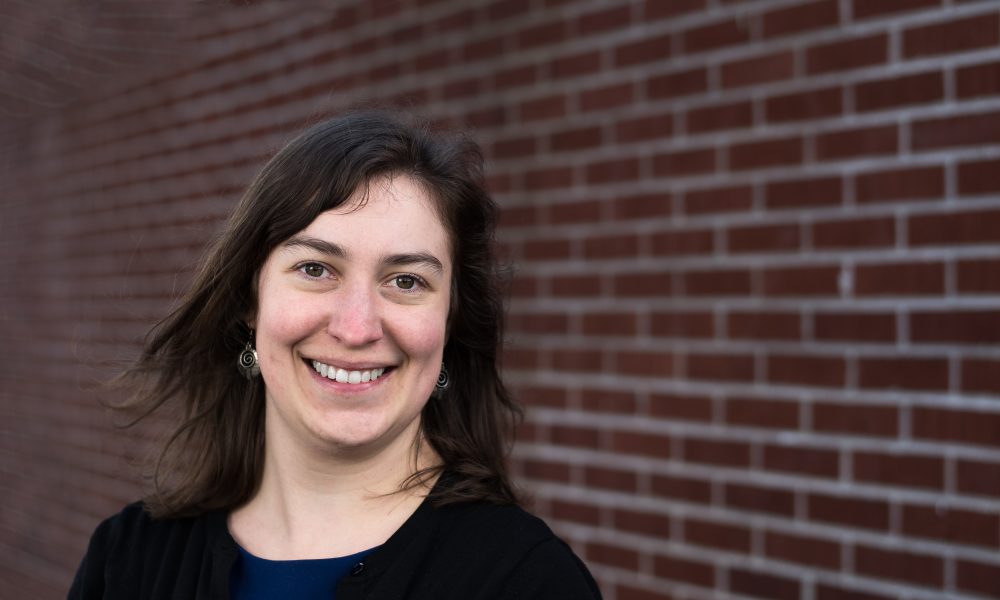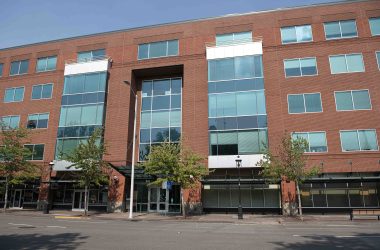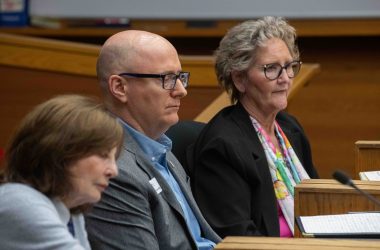
Reporter Rachel Alexander outside Four Corners Elementary (Fred Joe/Special to Salem Reporter)
This week, Salem Reporter is publishing “Nine into Six,” a five-part series highlighting the challenges facing Salem’s high poverty schools that are tasked with getting kids who come into kindergarten years behind their wealthier peers ready for middle school. (Read part one here.)
The idea for this series grew out of the annual ritual each fall when the state releases test score data for schools across Oregon.
The story those numbers suggested is one many readers are familiar with: students in the Salem-Keizer School District continue to lag behind their peers in Oregon, especially in elementary school. While some schools showed improvement across the district, the percentage meeting state standards was mostly stagnant, with some declines.
Those numbers form the basis of Oregon’s system of school accountability and guide how millions in federal and state money gets spent at the local level. But for the average parent, concerned citizen or reporter who’s new to writing about education, they don’t reveal much about what goes on day to day in the classroom or give many clues to evaluate local schools.
My editor, Les Zaitz, and I talked about how we might use achievement numbers as the basis of a story with more context.
What if we took a broader look at a few Salem-Keizer schools over the past five or ten years and used that context to show what’s being done to boost student achievement, where the district has made progress and where it’s lagged behind?
What if we went beyond the well-worn wisdom that schools serving richer students outperform schools serving poor ones to look at what’s being done to help kids who need quality public education the most?
We eventually settled on an idea: take three high-poverty schools in Salem with roughly similar demographics and look at how they’re performing, how they’re spending extra money and what challenges they have – in and outside the classroom. We wanted to explore how schools with the same kinds of students were producing such widely varying results.
I selected Four Corners, Hallman and Highland to focus on based on a review of state report card data and conversations with community and district leaders. I also spoke to the principals at each and they agreed to open up their schools to me and field an annoying number of questions.
My reporting over months included dozens of interviews with principals, teachers, instructional aides, union leaders, school board members and current and former Salem-Keizer and state education officials. I also spent hours in each of the three schools, talking to principals, observing staff development and group work, and watching classes.
My data analysis for each school included a review of state report cards and other district and state data from 2012 to present. I looked at test scores, improvement for individual students and the school as a whole, how discretionary funds were spent, kindergarten readiness, class size, teacher experience and retention, demographics, enrollment and chronic absenteeism.
We began publishing the series Tuesday, April 15, with a broad overview of the challenges facing Salem-Keizer schools. We’ll wrap up the five-part series at the end of the week, with feature stories on each individual school and a final piece with reflections from district leaders.
Every story was fact-checked following Salem Reporter’s principles. I verified every fact or quote against my own notes, using color-coded paperclips to mark interviews and observations according to the school they related to. I gathered data from state report cards and public records in a Google Sheet and verified those numbers again.

Tracking fact-checking emails in real time, complete with the terrible whiteboard handwriting universal to left-handed reporters. (Rachel Alexander/Salem Reporter)
Just as important, I reached back out to the educators, community members and others I interviewed for the stories to verify quotations and make sure my paraphrasing of their thoughts, challenges and information was accurate. Some sent me a simple “looks good!” while other took a red pen to nearly every sentence I’d written to make minor changes.
We don’t allow sources to change direct quotes or re-write stories for us, but those emails often served as a starting point for discussions and follow-up phone calls to clarify points. Several caught outright errors where I’d misunderstood a larger point, or let me know that an issue I’d thought was more foundational at a particular school was less of a concern to staff there.
It’s a time-consuming process, and it’s not perfect. Due to a miscommunication with district staff, some funding numbers I was given for the 2018-19 school year were preliminary and not accurate counts of how many federal dollars several schools received. Neither I, nor the staff, realized those numbers were wrong until several emails were exchanged about another point I was trying to clarify for a second story. We fixed the error about an hour after publishing the first story in the series.
Below are some notes on sourcing and the more technical aspects of the work.
There are several comparisons in the series between Salem-Keizer’s schools receiving Title I funding and others in the state. Those comparisons were made by joining the state’s report card file, available here, to the state’s list of Title I schools using the unique identification number the state assigns each school. From that list, I was able to further filter schools to look at those above a certain poverty rate or certain percentage of English learners.
When I refer to “elementary schools” in those comparisons, I’m referring to schools starting in either kindergarten or first grade and continuing to fifth or sixth grade. Oregon has every imaginable configuration of school, including K-8, K-12 and some serving only second and third grade. Because Salem-Keizer elementary schools are K-5, I opted only to include those schools with a similar configuration for comparison.
Data on kindergarten readiness is from Oregon’s annual assessment here. Specific numbers in articles refer to the number of lowercase English letters students recognize on average, though similar gaps exist for uppercase letters, basic math operations and English sound recognition.
Demographic information is taken from annual report cards for each school.
School spending per student data was downloaded from the Oregon Department of Education portal here.
Information on teacher experience, turnover and retention came from a public records request with the Salem-Keizer School District for a list of all licensed staff in each school each year from 2012 to present, including credited years of experience.
I used that data in conjunction with staff directories to identify teacher positions and examine how many staff were leaving each year. Numbers about average experience for teachers refer to medians for all licensed staff in the building, including the principals. (I ran calculations with and without principals included and they didn’t change the numbers much or change the rankings among the three schools.)
And for the history buffs, you can read President Lyndon Johnson’s full message to Congress in 1965 outlining the need for Title I funding here.

If you have questions or comments, please email them to [email protected].
Reporter Rachel Alexander: [email protected] or 503-575-1241.
Follow Salem Reporter on FACEBOOK and on TWITTER.
SUBSCRIBE TO SALEM REPORTER — For $10 a month, you hire our entire news team to work for you all month digging out the news of Salem and state government. You get breaking news alerts, emailed newsletters and around-the-clock access to our stories. We depend on subscribers to pay for in-depth, accurate news. Help us grow and get better with your subscription. Sign up HERE.

Rachel Alexander is Salem Reporter’s managing editor. She joined Salem Reporter when it was founded in 2018 and covers city news, education, nonprofits and a little bit of everything else. She’s been a journalist in Oregon and Washington for a decade. Outside of work, she’s a skater and board member with Salem’s Cherry City Roller Derby and can often be found with her nose buried in a book.









